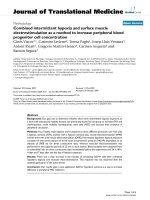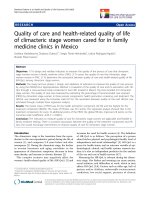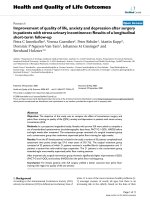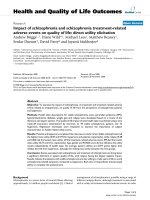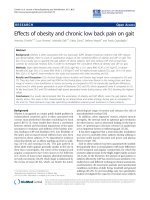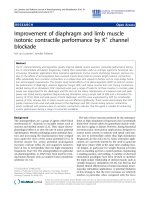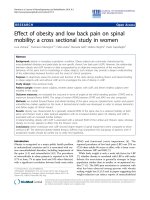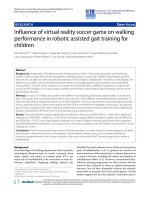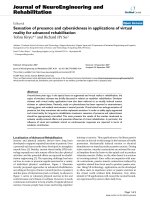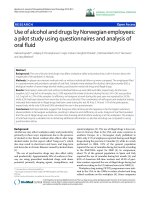báo cáo hóa học: "Improvement of diaphragm and limb muscle isotonic contractile performance by K+ channel blockade" pdf
Bạn đang xem bản rút gọn của tài liệu. Xem và tải ngay bản đầy đủ của tài liệu tại đây (323.96 KB, 9 trang )
RESEARC H Open Access
Improvement of diaphragm and limb muscle
isotonic contractile performance by K
+
channel
blockade
Erik van Lunteren
*
, Jennifer Pollarine
Abstract
The K
+
channel blocking aminopyridines greatly improve skeletal muscle isometric contractile performance during
low to intermediate stimulation frequencies, making them potentially useful as inotropic agents for functional neu-
romuscular stimulation applications. Most restorative applications involve muscle shortening; however, previous stu-
dies on the effects of aminopyridines have involved muscle being held at constant length. Isotonic contractions
differ substantially from isometric contractions at a cellular level with regards to factors such as cross-bridge forma-
tion and energetic requirements. The present study tested effects of 3,4-diaminopyridine (DAP) on isotonic contrac-
tile performance of diaphragm, extensor digitorum longus (EDL) and soleus muscles from rats. During contractions
elicited during 20 Hz stimulation, DAP improved work over a range of loads for all three muscles. In contrast, peak
power was augmented for the diaphragm and EDL but not the soleus. Maintenance of increased work and peak
power was tested during repetitive fatigue-inducing stimulation using a single load of 40% and a stimulation fre-
quency of 20 Hz. Work and peak power of both diaphragm and EDL were augmented by DAP for considerable
periods of time, whereas that of soleus muscle was not affected significantly. These results demonstrate that DAP
greatly improves both work and peak power of the diaphragm and EDL muscle during isotonic contractions,
which combined with previous data on isometric contractions indicates that this agent is suitable for enhancing
muscle performance during a range of contractile modalities.
Background
The aminopyridines are a group of agents which block
membranous K
+
channels in excitable tissues such as
neurons and skeletal muscle [1,2]. Their major electro-
physiological effect is to slow the rate of action potential
repolarization, thereby prolonging action potential dura-
tion and increasing the depolarization-time integral
(area under the curve of the action potential) [3-5]. In
skeletal muscle the action potential prolongation
increases calcium influx [6] and augments isometric
force at low to intermediate (but not high) stimulation
frequencies [3,4,7-10]. The aminopyridines (in particular
3,4-diaminopyridine, or DAP) have been used for treat-
ing human diseases such as Lambert-Eaton myasthenic
syndrome [11-14].
The lack of force increase produced by the aminopyri-
dines at high stimulation frequencies [8,15] potentially
limits t heir clinical utility for generalized muscle weak-
ness due to aging or disease. However, during functional
neuromuscular stimulation applications designed to
restore motor activity in subjects with spinal cord inju-
ries, low to intermediate rather than high stimulation
frequencies a re the rule [16,17]. S ome restorative appli-
cations are currently limited by the need to generate
highforcevalueswhileatthesametimeavoidingmus-
cle fatigue, in particular for weight bearing activities
such as stand ing up from a seated position, maintaining
a standing posture, and walking. A number of electrical
stimulation paradigms have been devised to optimize
the input-out put relationship of skelet al muscle, such as
variable frequency stimulation [18-22], but this has had
limited clinical effectiveness in human functional neuro-
muscular stimulation applications. A potential limitation
of this strategy is that the force increases are relatively
modest, in particular when compared with the force
* Correspondence:
Division of Pulmonary & Critical Care Medicine, Louis Stokes Cleveland
Department of Veterans Affairs Medical Center and Case Western Reserve
University, Cleveland, OH 44106, USA
van Lunteren and Pollarine Journal of NeuroEngineering and Rehabilitation 2010, 7:1
/>JNER
JOURNAL OF NEUROENGINEERING
AND REHABILITATION
© 2010 van Lunteren and Pollarine; licensee BioMed Central Ltd. This is an Open Access article distributed unde r the terms of the
Creative Commons Attribution License ( which permits unrestricted use, distribution, and
reproductio n in any medium , provided the original work is properly cited.
augmentation that can be achieved pharmacologically
with DAP [9].
The inotropic ef fects on skeletal muscle of DAP an d
other aminopyridines has been studied extensively under
isometric contractile condi tions, during which there is
force generation without shortening. Findings in normal
rat diaphragm muscle for DAP include twitch force
increases o f ~70 to 180% (depending on age, exercise
status and strain), a large left-ward shift of the force-fre-
quency relationship, good maintenance of force
increases during fatigue-inducing stimulation, and vari-
able prolongations of isometric contraction and half-
relax ation times [4,8-10,23]. Limited data directly exam-
ining the effects of DAP [10] and other aminopyridines
[24-26] suggest heterogeneity of contractile improve-
ments for muscles with different slow vs fast fiber type
composition when assessed under isometric conditions.
Many functional tasks involve a combination of non-
shortening and shortenin g contractions, often with dif-
ferent muscles performing one type or the other, but in
some instances with one muscle engaging in both types
of contractions during different phases of the task
[27,28]. Isometric and isotonic contractions differ from
each other with regards to actin-myosin cross-bridge
formation and cell ular energetics. As a result, in forma-
tion about DAP effects on contractile performance
under isometric conditions can not be extrapolated to
isotonic conditions, especially during the course of repe-
titive fatigue-inducing contractions. The hypothesis of
the present study is that DAP improves the isotonic
contractile performance of skeletal muscles, but in a
non-uniform manner among skeletal muscles.
Methods
All studies were approved by the Institutional Animal
Care and Use Committee and complied with NIH ani-
mal care guidelines. Seventeen Sprague-Dawley rats
obtained from Charles Rivers (Wilmington, MA) were
studied when they weighed 338 ± 15 g. Rats were
anesthetized with rodent anesthesia cocktail (initial
dose, ketamine 21-30 mg/kg, xylazine 4.3-6.0 mg/kg and
acepromazine 0.7-1.0 mg/kg, with supplemental smaller
doses given as needed to produce and maintain a deep
level of anesthesia). Soleus, extensor digitorum longus
(EDL), and diaphragm were removed surgically. Muscles
were initially placed in aerated (95% O
2
-5% CO
2
)phy-
siological solution which was kept at room temperature.
The composition of the physiological solution was con-
sistent with previou s studies (in mM) [4,8-11,22]: NaCl
135, KCl 5, CaCl2 2.5, MgSO4 1, NaH2PO4 1, NaHCO3
15, glucose 11, with the pH adjusted to 7.35-7.45. The
diaphragm was cut into strips that were ~3 mm wide,
whereas EDL and soleus muscles were kept intact and
not cut. Special care wa s taken to k eep the tendinous
and b ony origins and insertions of each muscle sample
intact. The muscle samples were subsequently mounted
vertically in a double-jacketed bath containing physiolo-
gical solution kept at a constant 37°C which was aerated
(95% O
2
-5% CO
2
) continuously. Muscles were attached
to a transducer (model 305, Aurora Scientific, Onta rio,
Canada). This dual -mode servo-controlled force trans-
ducer measured force and length separately, and held
force constant while changes in length were measured.
The muscle strips underwent electrical stim ulation with
a pulse width of 1 msec [4,8] via parallel platinum elec-
trodes placed ~4 mm apart with the muscle situated in
the middle [4,8-10]. Supramaximal voltages were used;
voltage was increased until there was no further increase
in the magnitude of the contraction, and then an addi-
tional 20% was added to this value [4,8-10]. All muscle
strips were tested at optimal length (L
o
) based on twitch
force. In a previous study of isometric contractions
using the same in vitro approach we have found for dia-
phragm, soleus and EDL that force of muscles incubated
with no drug were stable over 20 minutes (which is
similar t o the time needed for the present studies) and,
furth ermore, DAP effects could easil y be discerned rela-
tive to force values of muscle samples that were not
treated with drug [[10], and unpublished data].
The study consisted of two parts, a) delineation of
DAP effects on isotonic contractile performance as a
function of load when stimulated at 20 Hz, and b) deter-
mination of the extent to which DAP improves isotonic
contractions over time during fatigue-inducing stimula-
tion. Separate muscle samples w ere used f or each part
of the study. The DAP concentration used throughout
was 0.3 mM, which was chosen because it was t he low-
est amount that resulted in a near-maximal force
increase in rat diaphragm muscle [8] and has been used
for several subsequent diaphragm isometric studies
[4,9,10]. In addition, in a study comparing isometric
contractions of diaphragm, soleus and EDL, a concen-
tration of 0.3 mM resulted in the maximum force
increase that was sustained over time for all three mus-
cles [10]. A stimulation frequency of 20 Hz was chosen
for both portions of the present study, based on DAP
and other aminopyridines improving isometric force at
low to intermediate (~1 to 50 Hz) but not high stimula-
tion frequencies [8,24,29], and that previous studies of
DAP effects on isometric fatigue in rat muscle used this
stimulation frequency [4,8,10,23], thereby facilitating
comparisons of isotonic with previous isometric data.
In order to assess DAP effects on isotonic contractions
as a function of l oad, muscles were stimulated for 333
msec at seven different loads (5, 10, 20, 30, 40, 50 and
60% load) with a minute of no stimulation in between
each load so as to prevent fatigue. DAP (0.3 mM) or
additional physiological solution was incubated for 10
van Lunteren and Pollarine Journal of NeuroEngineering and Rehabilitation 2010, 7:1
/>Page 2 of 9
min before the seven loads were tested again. Compari-
sons were made for the post-D AP versus pos t-no drug
data to factor out the effects of repeated stimulation.
The l oads for all parts of the study were percentages of
maximum force during 20 Hz stimulation before the
addition of DAP or no drug. The choice of using peak
force during 20 Hz stimulation rather than tetanic force
to define maximum load was based on two considera-
tions. First, it is consistent with the approach used in
our previous studies of muscle isotonic contractile prop-
erties [30,31]. Second, the present study was performed
in the context of functional electrical stimulation, and
thus it is more meaningful to base loads on force pro-
duced during the frequency at which the muscle will be
stimulated.
Muscle fatigue wa s tested at a single load of 40% for
all muscles. The load of 40% was chosen because it
yielded approximately maximum work for all three mus-
cles. Separate samples were tested in the absence and
presence of DAP, so that drug and no-drug data were
obt ained from mus cle samples which underwent identi-
cal stimulation paradigms. For fatigue testing, muscles
were stimulated at 20 Hz using a train duration of 333
ms, with one train every 2 sec. Muscle length always
returned to baseline in between stimulus trains, allowing
total shortening and maximum velocity of shortening to
be calculated for each stimulus train. Changes in con-
tractile parameters were measured over time. To factor
out DAP effects on contractile parameters at the onset
of stimulation, a fatigue index was calculated as the con-
tractile parameter at the end of 2 minutes of stimulation
relative to the initial value.
Data were relayed to a computer using the data acqui-
sition and analysis program Dynamic Muscle Control
(Aurora Scientific Inc., Ontario, Canada). Muscle perfor-
mance was evaluated by measuring work and power.
Work was calculated as the product of the isotonic
afterload and the total amount of shortening during
each train (the difference between muscle length when
not stimulated and the maximum amount of shortening
that occurred during the train). Peak power was calcu-
lated as the product of the isotonic afterload and short-
ening velocity, with velocity measured during the early
portion of the contraction when it was at or near its
maximal value for each train [30-32].
Data were analyzed statistically using 2-way RMA-
NOVA; for the load curves the factors were load and
DAP treatment, whereas for fatigue testing the factors
were duration of stimulation and DAP treatment. RMA-
NOVA was followed with the Newm an-Kuels test when
significance was found to evaluate the effects of DAP
treatment. Twitch contraction and fatigue index data
were analyzed with paired and unpaired t tests, respec-
tively. Probability values of P ≤ 0.05 were considered to
be statistically significant. Data appear as mean values ±
1 SE.
Results
20 Hz Contractions at Various Loads
An example of muscle lengt h tracings of the diaphragm
during isotonic contractions is depicted in Figure 1,
demonst rating representative increases in muscle short-
ening by DAP at two loads. Work was increased by
DAP for the diaphragm (P = 0.001), EDL (P = 0.007)
and soleus (P = 0.01) muscles (Figure 2). For the dia-
phragm the increase was significant at loads ranging
from 20 to 60%, whereas for the EDL and soleus the
increases were significant at loads of 30 to 60%. The
effects of DAP on peak power, however, were more vari-
able among muscles (Figure 3), increasing signif icantly
for the diaphragm (P = 0.017) and EDL (P = 0.001) but
not for the soleus (P = 0.35). For the diaphragm peak
power was increased at lo ads of 20 to 50%, whereas
EDL power was increased significantly at l oads of 30 to
60%. In contrast, peak power was not significantly
increased for the soleus muscle at any load.
Fatigue During Repetitive Contractions
For the diaphragm, there was a brisk initial increase in
work near the onset of repetitive stimulation, which was
found both in the absence and presence of DAP (Figure
4). However, the magnitude of the early work incre ase
was augmented by DAP. The initial increase was fol-
lowed by progressive declines in work for both
untreated and DAP-treated muscle. Nonetheless, work
of DAP-treated muscle was significantly greater than
that of untreated muscle (P < 0.001), in particular for
thefirsthalfofthefatiguetesting period. Furthermore,
the fatigue index for work was higher in DAP-treated
than untreated muscle (indicating a smaller relative
drop in work over time with DAP) (Figure 5A). F or the
EDL, the transient work increase at the beginning of sti-
mulation was both increased and p rolonged by DAP,
and work wa s augmented by DAP (P = 0.001) for most
of the repetitive stimulation period (Figure 4). However
in contrast to the diaphragm, the work fatigue index
was similar in the presence and absence of DAP (Figure
5A). Work of the soleus muscle over time was not
affected by DAP (P = 0.69) (Figure 4), although the fati-
gue index was higher in DAP-treated than untreated
muscle (Figure 5A).
Peak power of the diaphragm was also augmented by
DAP during fatigue-inducing stimulation (P = 0.02) (Fig-
ure 6). This was also the case for the EDL (P = 0.01),
although the magnitude and duration of the increases
were generally smaller than for the diaphragm. However,
the fatigue index for peak power was not altere d by
DAP for ei ther diaphragm or E DL (Figure 5B). DAP did
not affect peak power of the soleus muscle over time (P
van Lunteren and Pollarine Journal of NeuroEngineering and Rehabilitation 2010, 7:1
/>Page 3 of 9
= 0.53) nor did it affect the soleus muscle power fatigue
index.
Discussion
The major finding of the present study was that DAP
can substantially improve the isotonic contractile perfor-
mance of skeletal muscle during contractions elicited by
20 Hz stimulation, albeit to a non-uniform extent
among skeletal muscles. For the diaphragm and EDL
muscles work and peak power were augmented during
contractions over a range of loads, and furthermore
these augmentations persisted over time during fatigue-
inducing repetitive stimulation when tested at a single
load (of 40%). In contrast, the beneficial effects of DAP
on so leus muscle isotonic contractile p erformance were
much more limited, and were noted for work (and thus
for extent o f shortening) but not for peak power (and
thus not for peak velocity of shortening).
Most isometric data for DAP have been obtained with
diaphragm muscle [4,8-10,15,23], and we will therefore
initially focus on diaphragm data from the present study
for comparisons of cur rent isotonic and previous iso-
metric data. The first conclusion from such comparisons
is that DAP improves diaphragm performance over a
range of loading conditions, ranging from small to inter-
mediate loads in which there is considerable shortening
(present study) to very large loads which prevent
shortening altogether (previous isometric studies). The
second conclusion is that the magnitude of the
improved diaphragm contractile performance with DAP
is large for both isotonic and isometric contractions. As
noted in the introduction, the magnitude of isometric
twitch force increases for the diaphragm is in the range
of 70 to 180%. Values for diaphragm twitch force
increases from three studies in sedentary young adult
SpragueDawleyrats(similartothoseusedinthepre-
sent study) averag ed 111%, an d the isometr ic force
increases during 20 Hz stimul ation were similar in size
[8,10,23]. In the present study, DAP-induced increases
in diaphragm work and peak power during isotonic con-
tractions varied as a function of load (Figures 1, 2, 3).
None theless, improvements in isotonic contractile para-
meters were in many instances as large as the force
increases found during isometric contractions. A third
conclusion is that DAP-induced increases in diaphragm
contractile performance are well-maintained over the
course of fatigue-inducing repetitive stimulation during
both isometric (previous studies) and isotonic (Figures
4, 5, 6) contractions. In the present study during iso-
tonic contractions work and power was significantly ele-
vated by DAP for the first 40-60 seconds of a two
minute repetitive stimulation period, and contractile
performance of DAP-treat ed muscle never declined
below that of untreated muscle through the two minutes
Diaphragm 40% Load
Time (s)
0.0 0.2 0.4 0.6 0.8
-5
-4
-3
-2
-1
0
1
Diaphragm 20% Load
Time (s)
0.0 0.2 0.4 0.6 0.8
Muscle Length (mm with respect to optimal length)
-5
-4
-3
-2
-1
0
1
Control
DAP
Figure 1 Examples of diaphragm isotonic shortening at two different loads in the presence and absence of 3, 4-diaminopyridine
(DAP). Optimal length of this muscle sample was 21 mm.
van Lunteren and Pollarine Journal of NeuroEngineering and Rehabilitation 2010, 7:1
/>Page 4 of 9
of stimulation. This is comparable to the 30- 80 second
duration of isometric force improvement by DAP found
during previous in vitro studies of normal rat diaphragm
muscle [4,8,10,22].
There are several studies which have compared the
effects of aminopyridines on the isometric contractile
performance of different muscles, although most studies
used 4-aminopyridine rather than DAP. It should be
kept in mind that 4-aminopyridine produces smaller
force increases and lesser degrees of action potential
prolongation than DAP [4,5,8,10,24,33]. Only four stu-
dies compared responses of different muscles directly.
The first found that 4-aminopyridine improved twitch
force of the tibialis anterior muscle but n ot the soleus
muscle [26]. The second study found similar force
increases for rat diaphragm (64%) and sternohyoid mus-
cle (55%) in response to 4-aminopyridine [24]. The third
Soleus
Load (%)
5102030405060
0
20
40
60
80
100
120
140
EDL
5102030405060
Work (Joules/m
2
)
0
20
40
60
80
Diaphragm
5102030405060
0
20
40
60
80
100
120
140
160
No DAP
DAP
P=0.010
P=0.007
P=0.001
*
*
*
*
*
*
*
*
*
*
*
*
*
Figure 2 Effects of 3,4-diaminopyridine (DAP) on isotonic work
of diaphragm, extensor digitorum longus (EDL) and soleus as
a function of load during 20 Hz stimulation. P values indicate
results of 2-way RMANOVA testing for each panel, and asterisks (*)
indicate significant differences at each load per the Newman-Kuels
test.
Soleus
Load
(
%
)
5102030405060
0
200
400
600
800
1000
1200
EDL
5102030405060
Power (Watts/m
2
)
0
2000
4000
6000
8000
Diaphragm
5102030405060
0
1000
2000
3000
4000
No DAP
DAP
P=0.352
P=0.001
P=0.017
*
*
*
*
*
*
*
*
Figure 3 Effects of 3,4-diaminopyridine (DAP) on peak isotonic
power of diaphragm, extensor digitorum longus (EDL) and
soleus as a function of load during 20 Hz stimulation. P values
indicate results of 2-way RMANOVA testing for each panel, and
asterisks (*) indicate significant differences at each load per the
Newman-Kuels test.
van Lunteren and Pollarine Journal of NeuroEngineering and Rehabilitation 2010, 7:1
/>Page 5 of 9
found that 4-aminopyridine increased rat diaphragm
twitch force to a greater extent (71 ± 7%) than that of
two limb muscles, the extensor digitorum longus (28 ±
11%) and the soleus muscle (22 ± 3%) [25]. The most
recent study found that DAP-induced force increases
were greater for diaphragm and EDL than soleus, but
that the force increases were ma intained for a longer
time for soleus than diaphragm than EDL [10]. Thus
isometric data paint a p icture of considerable diversity
among muscles in the degree to which contractile per-
formance is altered by the aminopyridines, with which
the present study is in agreement.
The present study used a single stimulat ion frequency
(20 Hz) for all three muscles. This frequency differs
among muscles in terms of how this relates to their nat-
ural motor unit firing frequencies during normal
Time (min)
0.0 0.5 1.0 1.5 2.0
Work (Joules/m
2
)
0
50
100
150
200
250
No DAP
DAP
Time (min)
0.0 0.5 1.0 1.5 2.0
0
20
40
60
80
100
120
140
P<0.001
*
*
*
*
*
*
*
Time (min)
0.0 0.5 1.0 1.5 2.0
0
20
40
60
80
100
120
140
*
*
*
*
*
*
*
*
P=0.001
*
*
Diaphragm
EDL
Soleus
P=0.690
Figure 4 Effects of 3,4-diaminopyridine (DAP) on changes in isotonic work of diaphragm, extensor digitorum longus (EDL) and soleus
during repetitive 20 Hz stimulation at a load of 40%. P values indicate results of 2-way RMANOVA testing for each panel, and asterisks (*)
indicate significant differences at each load per the Newman-Kuels test.
Soleus
0.0
0.2
0.4
0.6
0.8
1.0
Diaphragm
Work Fatigue Index
0.0
0.1
0.2
0.3
0.4
0.5
No DAP
DAP
EDL
0.00
0.05
0.10
0.15
0.20
0.25
0.30
Diaphragm
Power Fatigue Index
0.0
0.1
0.2
0.3
0.4
0.5
EDL
0.00
0.02
0.04
0.06
0.08
0.10
Soleus
0.0
0.2
0.4
0.6
0.8
1.0
1.2
*
**
A
B
NS
NS
NS
NS
Figure 5 Effects of DAP on fatigue indexes for isotonic work (A) and peak power (B) of diaphragm, extensor digitorum longus (EDL)
and soleus during repetitive 20 Hz stimulation at a load of 40%. Asterisks indicate significant increases: ** P ≤ 0.01, * P < 0.05, NS = not
significant.
van Lunteren and Pollarine Journal of NeuroEngineering and Rehabilitation 2010, 7:1
/>Page 6 of 9
behaviors in the intact animal, with faster muscles such
as the EDL being activated normally at higher frequen-
cies than slower muscles such as the soleus [34], as well
as how it relates to their force-frequency relationships,
with 20 Hz causing greater degree of contractile fusion
in slower muscles such as the soleus compared with fas-
ter muscles such as the EDL. DAP and other aminopyri-
dines prolong action potential duration [3-5] thereby
increasing calcium influx [6] and enhancing muscle con-
traction [ 3,4,7-10]. Thus DAP-treated muscle stimulated
at a low frequency of stimulation should achieve the
same intracellular calcium concentrations and hence
force production as untreated muscle stimulated at a
higher stimulation frequency - and this is borne out by
data on force-frequency relationships of untreated and
DAP-treated muscle studied during isometric contrac-
tions [8]. During 20 Hz stimulation (without DAP),
soleus contractions are already quite fused and thus the
additional degree of fusion with DAP does not augment
shortening much if at all; at 20 Hz (without DAP) dia-
phragm contractions are right at the threshold of being
fused (see in particular left panel of Figure 1) and thus
DAP enhances fusion a lot and thus increases muscle
shortening considerably; and at 20 Hz (without DAP)
EDL c ontractions are further away than the diaphragm
from the fusion threshold, and thus DAP produces a
more modest amount of fusion and thus a smaller aug-
mentation of muscle shortening. There may also be
other mechanisms in addition to the above ac counting
for differences among muscles in DAP effects. There are
multiple types of K
+
channels, including multiple sub-
types of delayed rectifier K
+
channels, in skeletal muscle,
and various channel types and subtypes may have differ-
ential sensitivity to aminopyridines including DAP. It is
possible (albeit speculative) that the three muscles
studied have different proportions of various K
+
channel
types and subtypes, with the diaphragm having the high-
est proportion of K
+
channel subtypes with high DAP
sensitivity.
Conclusions
The aminopyridines have been used for treating human
diseases such as Lambert-Eaton myasthenic syndrome,
with DAP being preferred over 3,4-aminipyridine due to
reduced crossing of the blood-brain barrier and thus
lower propensity to cause neurological side effects
[11-14]. The present data, combined with previous iso-
metric studies, have several implications for the potential
clinical use of DAP to augment skeletal muscle contrac-
tile performance during functional neuromuscular stimu-
lation applicat ions. First is that DAP appears to b e
effective over a range of loads, and therefore suitable for
both isometric and isoton ic (and presumably also mixed)
restorative applica tio ns. Second is that the DAP-induced
contractile augmentations can be maintained over time
during repetitive fatigue-inducing stimulation under both
isotonic and isometric conditions. It should be noted in
this regard that fatigue occurs much more rapidly with in
vitro than in vivo muscle preparations [10,15], so that it
is quite possible that the contractile augmentations in
vivo will be longer lasting than those depicted in the pre-
sent study. Not yet known is whether DAP affects recov-
ery from fatigue and whether the salutatory effects of
DAP on contractile performance would be equally large
during a second set of contractions following a recovery
period as it had been during the initial set of contrac-
tions. Thi rd is that one should expect differences among
skeletal muscles in the degree of inotropic effects pro-
vided by DAP during both isotonic and isometric c on-
tractions, which may in part be influenced by the
Time (min)
0.0 0.5 1.0 1.5 2.0
Power (Watts/m
2
)
0
1000
2000
3000
4000
5000
No DAP
DAP
P=0.020
*
*
*
*
*
Time (min)
0.0 0.5 1.0 1.5 2.0
0
2000
4000
6000
8000
10000
*
*
*
*
P=0.010
Diaphragm
EDL
Soleus
Time (min)
0.0 0.5 1.0 1.5 2.0
0
500
1000
1500
2000
P=0.528
Figure 6 Effects of 3,4-diaminopyridine (DAP) on changes in isotonic peak power of diaphragm, extensor digitorum longus (EDL) and
soleus during repetitive 20 Hz stimulation at a load of 40%. P values indicate results of 2-way RMANOVA testing for each panel, and
asterisks (*) indicate significant differences at each load per the Newman-Kuels test.
van Lunteren and Pollarine Journal of NeuroEngineering and Rehabilitation 2010, 7:1
/>Page 7 of 9
stimulation frequency used for muscle activation relative
to the normal activation rates of each muscle when acti-
vatedbythebraininvivoaswellastheforce-frequency
relationships of ea ch muscle. Variability among muscles
might be less of an i ssue for spinal cord injury subjects,
in that th e upper motoneuron denervation results in all
affected muscles acquiring a fast-contraction and fast-
myosin phenotype. On the other hand, muscles typically
undergo a reconditioning paradigm as part of functional
neuromuscular stimulation programs. This results in a
movement towards a slower phenotype, and it is possible
that DAP effect s may therefore change during the course
of the reconditioning program. On the other hand, a
complete con vers ion to a slow phenotype is typica lly not
produced by the reconditioning programs used for limb
and diaphragm muscle restorative applications (in con-
trast to cardiomyopla sty applications), and both previous
isometric studies and the present isotonic study indicat e
that a mixed muscle such as the diaphragm responds
nicely to DAP by increasing force, peak power and work.
List of Abbreviations
DAP: 3,4-diaminopyridine; EDL: extensor digitorum
longus.
Acknowledgements
These studies were supported by grants to EvL from the Department of
Veterans Affairs, Veterans Health Administration. The funding body had no
role in the study design; collection, analysis and interpretation of data; in the
writing of the manuscript; and the decision to submit the manuscript for
publication. These studies were supported by grants from the Department
of Veterans Affairs, Veterans Health Administration.
Authors’ contributions
EvL conceived of the study, participated in the design of the study,
participated in the data analysis, and participated in writing the manuscript.
JP participated in the design of the study, carried out the contractile studies,
performed the statistical analysis, and participated in writing the manu script.
All authors read and approved the final manuscript.
Competing interests
The authors declare that they have no competing interests.
Received: 14 May 2009
Accepted: 11 January 2010 Published: 11 January 2010
References
1. Gillespie JI: Voltage-dependent blockage of the delayed potassium
current in skeletal muscle by 4-aminopyridine. J Physiol (London) 1977,
273:64-65.
2. Gillespie JI, Hutter OF: The actions of 4-aminopyridine on the delayed
potassium current in skeletal muscle fibers. J Physiol (London) 1975,
252:70-71.
3. Delbono O, Kotsias BA: Relation between action potential duration and
mechanical activity on rat diaphragm fibers. Effects of 3,4-
diaminopyridine and tetraethylammonium. Pflugers Arch 1987, 410:394-
400.
4. van Lunteren E, Moyer M: Electrophysiologic and inotropic effects of K
+
channel blockade in aged diaphragm. Am J Respir Crit Care Med 1998,
158:820-826.
5. van Lunteren E, Moyer M, Dick TE: Modulation of diaphragm action
potentials by K
+
channel blockers. Respir Physiol 2001, 124:217-230.
6. Miledi R, Parker I, Schalow G: Measurement of calcium transients in frog
muscle by the use of arsenazo III. Proc R Soc Lond B 1977, 198:201-210.
7. Lin-Shiau SY, Day SY, Fu WM: Use of ion channel blockers in studying the
regulation of skeletal muscle contractions. Naunyn-Schmiedeberg’s Arch
Pharmacol 1991, 344:691-697.
8. van Lunteren E, Moyer M: Effects of DAP on diaphragm force and fatigue,
including fatigue due to neurotransmission failure. J Appl Physiol 1996,
81:2214-2220.
9. van Lunteren E, Moyer M: Combination of variable frequency train
stimulation and K
+
channel blockade to augment skeletal muscle force.
IEEE Trans Neural Syst Rehabil Eng 2004, 12:288-294.
10. van Lunteren E, Pollarine J, Moyer M: Inotropic effects of the K
+
channel
blocker 3,4-aminopyridine: differential responses of rat soleus and extensor
digitorum longus. IEEE Trans Neural Syst Rehabil Eng 2006, 14:419-426.
11. Lundh H, Nilsson O, Rosen I: Treatment of Lambert-Eaton syndrome: 3,4-
diaminopyridine and pyridostigimine. Neurology 1984, 34:1324-1330.
12. McEvoy KM, Windebank AJ, Daube JR, Low PA: 3,4-Diaminopyridine in the
treatment of Lambert-Eaton myasthenic syndrome. N Engl J Med 1989,
321:1567-1571.
13. Newsom-Davis J: A treatment algorithm for Lambert-Eaton myasthenic
syndrome. Ann N Y Acad Sci 1998, 841:817-22.
14. Sanders DB, Massey JM, Sanders LL, Edwards LJ: A randomized trial of 3,4-
diaminopyridine in Lambert-Eaton myasthenic syndrome. Neurology
2000, 54:603-607.
15. van Lunteren E, Moyer M, Pollarine J: Long-lasting in vivo inotropic effects
of the K+ channel blocker 3,4-diaminopyridine (DAP) during fatigue-
inducing stimulation. Muscle Nerve 2008, 38:1616-1622.
16. Bhadra N, Peckham PH: Peripheral nerve stimulation for restoration of
motor function. J Clin Neurophysiol 1997, 14:378-393.
17. Glenn WWL, Brouillette RT, Dentz B, Fodstad H, Hunt CE, Keens TG,
Marsh HM, Pande S, Piepgras DG, Vanderlinden RG: Fundamental
considerations in pacing of the diaphragm for chronic ventilatory
insufficiency: a multi-center study. PACE 1988, 11:2121-2127.
18. Bigland-Ritchie B, Zijdewind I, Thomas CK: Muscle fatigue induced by
stimulation with and without doublets. Muscle Nerve 2000, 23:1348-1355.
19. Binder-Macleod SA, Barrish WJ: Force response of rat soleus muscle to
variable-frequency train stimulation. J Neurophysiol 1992, 68:1068-1078.
20. Burke RE, Rudomin P, Zajac FE: Catch properties in single mammalian
motor units. Science 1970, 168:122-124.
21. Burke RE, Rudomin P, Zajac FE: The effect of activation history on tension
production by individual muscle units. Brain Res 1976, 109:515-529.
22. van Lunteren E, Sankey CB: The catch-like property of rat diaphragm:
subsequent train frequency effects in variable train stimulation. J Appl
Physiol 2000, 88:586-598.
23. van Lunteren E, Moyer M: Wheel running exercise alters rat diaphragm
action potentials and their regulation by K
+
channels. J Appl Physiol 2003,
95:602-610.
24. van Lunteren E, Vafaie H, Moyer M: Changes in pharyngeal respiratory
muscle force produced by K
+
channel blockade. Respir Physiol 1995,
99:331-340.
25. van Lunteren E: Differential inotropic effects of 4-aminopyridine and
tetraethylammonium on rat diaphragm and limb muscles. Basic Appl
Myol 1999, 9:53-59.
26. Agoston S, Bowman WC, Houwertjes MC, Rodger IW, Savage AO: Direct
action of 4-aminopyridine on the contractility of a fast-contracting
muscle in the cat. Clin Exp Pharmacol Physiol 1982, 9:21-34.
27. Dickinson M, Farley C, Full R, Koehl M, Kram R, Lehman S: How animals
move: an integrative review. Science 2000, 288:100-106.
28. Rome LC: Functional morphology of proximal hindlimb muscles in the
frog Rana pipiens. J Exp Biol 2002, 205:1987-2004.
29. van Lunteren E, Moyer M: Improvement of dy/dy
dystrophic diaphragm by K
+
channel blocker 3,4-diaminopyridine.
Muscle Nerve 2002, 26:71-78.
30. Pollarine J, Moyer M, van Lunteren E: Isotonic fatigue in laminin a2
deficient dy/dy dystrophic mouse diaphragm. Muscle Nerve 2007, 36:672-
678.
31. van Lunteren E, Pollarine J, Moyer M: Isotonic contractile impairment due
to genetic CLC-1 chloride channel deficiency in myotonic mouse
diaphragm muscle. Exp Physiol 2007, 92:717-729.
32. Watchko JF, Daood MJ, Sieck GC, LaBella JJ, Ameredes BT, Koretsky AP,
Wieringa B: Combined myofibrillar and mitochondrial creatine kinase
van Lunteren and Pollarine Journal of NeuroEngineering and Rehabilitation 2010, 7:1
/>Page 8 of 9
deficiency impairs mouse diaphragm isotonic function. J Appl Physiol
1997, 82:1416-1423.
33. van Lunteren E, Moyer M, Torres A: Effect of K
+
channel blockade on
fatigue in rat diaphragm muscle. J Appl Physiol 1995, 79:738-747.
34. Hennig R, Lømo T: Firing patterns of motor units in normal rats. Nature
1985, 314:164-166.
doi:10.1186/1743-0003-7-1
Cite this article as: van Lunteren and Pollarine: Improvement of
diaphragm and limb muscle isotonic contractile performance by K
+
channel blockade. Journal of NeuroEngineering and Rehabilitation 2010 7:1.
Publish with BioMed Central and every
scientist can read your work free of charge
"BioMed Central will be the most significant development for
disseminating the results of biomedical research in our lifetime."
Sir Paul Nurse, Cancer Research UK
Your research papers will be:
available free of charge to the entire biomedical community
peer reviewed and published immediately upon acceptance
cited in PubMed and archived on PubMed Central
yours — you keep the copyright
Submit your manuscript here:
/>BioMedcentral
van Lunteren and Pollarine Journal of NeuroEngineering and Rehabilitation 2010, 7:1
/>Page 9 of 9
